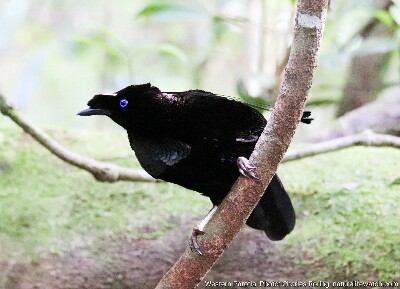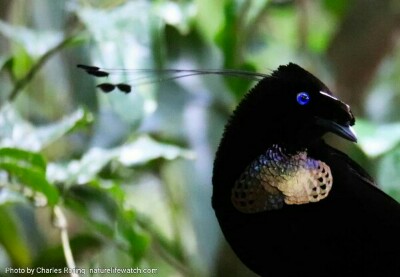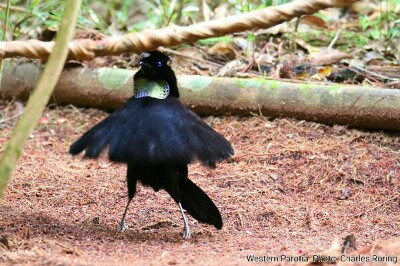Last week, I visited the tropical rainforest of Arfak range. It was located around 2 hours by 4wd car from Manokwari city. I was guiding 2 American tourists at that time. They were birdwatchers. We spent 5 days/ 4 nights in the forest to watch several species of birds of paradise and other tropical birds. One of the paradise birds that attracted our attention was Western Parotia (Parotia sefilata). The bird lived in an elevation of approximately 1,400 m to 2,000 meters above sea level.

On the second day of our stay in the mountains, we woke up early in the morning at 04.30. It was still dark outside. We had to make preparations by wearing dark color t-shirt, long pants as well as making sure that all our birdwatching equipment were already inside our bags. There was still time for us to drink tea/coffee and to have some biscuits or bread. At 05.10, we left the guesthouse for the dancing ground of Western Parotia. We used flashlight. Slowly we walkep up steep slopes of Mount Soyti through to big trees and thick shrubs. Some parts of the foothpath that were steep had steps.
Around twenty minutes later, we reached our birding ground. We still had to enter a birding hut that was made of corrugated metal roofs. There were holes at the front side of the hut that faces the dancing ground of Western Parotia. Visitors could watch the birds using binoculars or shoot them using their cameras. Next to the dancing site, villagers had put a big red pandanus fruit on a wooden frame around 1.5 meters above the ground. In less than 3 minutes after we entered the hut, a brown bird landed on the fruit. It was a female Superb Bird of Paradise. She immediately ate the grains of the fruits.

Several minutes later, a male Western Parotia came. He perched on a branch of a tree in front of our observation hut. He began calling his female counterparts several times and then jumped to lower branches and hanging vines. Ha landed on the ground which was his dancing stage. He started to pick up fallen leaves and twigs and threw them away. He cleared the ground as his preparations prior to performing his courtship dance. While he was working, sometimes he practiced dancing. His feather expanded to look like a skirt. We considered him acting like a human ballerina performing on a stage in front of a lot of audiences.
Some female Western Parotia landed on the red fruit. They also ate its grains. Seeing their presence on the fruits he flew to wooden frame that supported the fruit and began to make weird sounds towards the female birds. He was asking them, perhaps, to watch his dance performance and then to mate with him. They kept on eating the fruits but shortly after that flying to the branch of the tree above the dancing ground. Seeing this golden opportunity, the male Western Parotia landed on his dancing ground and did some clearing again. After that he performed his courtship dance. He shook his head while standing, he walked to his left and right sides. He jumped several times.

For us, human, who were watching his dance, it was a fantastic show, a beautiful dance performance. Unfortunately, for two female Western Parotia that were watching from higher branch, it was not that fantastic. They were not impressed by the show. They flew away leaving the male Western Parotia in despair.
There were several other species that we saw while waiting inside the observation hut. Some of them include Long-tailed Paradigalla, Black Sicklebill (mother and daughter) as well as Blue Grey Robin, Black-eared Catbird and Black Fantail birds.
At 09.00 we finished watching the Western Parotia and slowly walked down the slopes back to the guesthouse again.
Birding Devices
To take pictures of the birds, I used Canon 200D and Tamron 150-600 mm G2 telephoto lens. Under lowlight condition, I used sports mode, and activated the lens' vibration control to level 3. I did not use tripod. The pictures that this photographic device made were quite good for this trip report.
I used a good pair of Visionking 10×42 mm binoculars. My clients used the Leica binoculars which were a world class brand. They brought a Celestron spotting scope with cell phone adaptor. It was a great birding device because they were able to take pictures and videos of the paradise birds using a small smartphone.
There is a village in Arfak mountains where tourists can visit to watch this ballerina bird. Its name is Mbenti. Birdwatchers need to charter a 4wd car to reach the village. A local guide named Krif Indow can arrange trips to Mbenti village. His whatsapp number is: +62 821-9937-3276.
In addition to the Ballerina Bird, visitors can also watch other birds when they explore the rainforest of Mbenti village. Some of them include Black-breasted Boatbill, Vogelkop Melidectes, Ornate Melidectes, Cinnamon-browed Melidectes, Papuan Flycatcher, Black Berrypecker, Tit Berrypecker, Olive-crowned Flowerpecker, Garnett Robin, Mottled Berryhunter, Friendly Fantail, Green-backed Robin, Blue Grey Robin, Yellow-billed Lorikeet, Plum-faced Lorikeet, Black-winged Monarch, Pygmy Drongo, Golden Face, Papua Mountain Pigeon, Montane Peltop, and a lot more. This is written by Charles Roring